
eBook Answer Keys are now available through VitalSource.com! Please visit their website for more information on pricing and availability.
This answer key is to be used with Al-Kitaab fii Ta callum al-cArabiyya: A Textbook for Beginning Arabic: Part Two, Third Edition. Please note that this answer key contains answers for exercises that are in the book. It does not contain answers for exercises formerly on the Smart Sparrow Companion Website, which is no longer available after January 1, 2021.

eBook answer keys are now available on VitalSource.com! Please visit their website for more information on pricing and availability.
This answer key is to be used with Alif Baa: Introduction to Arabic Letters and Sounds, Third Edition. Please note that this answer key contains answers for exercises that are in the book. It does not contain answers for exercises formerly found on the Smart Sparrow Companion Website, which is no longer available after January 1, 2021.

This answer key is to be used with Al-Kitaab fii Ta callum al-cArabiyya: A Textbook for Beginning Arabic: Part One, Second Edition.
The answer key for Al-Kitaab, Part One is intended as a resource for teachers and for learners studying on their own. The answer key includes:• text of all audio sentences included in the vocabulary section of each lesson. • text of the basic "story" of Maha and Khaled in each lesson • answers to most vocabulary, grammar and review drills included in each lesson.

This answer key is to be used with Alif Baa with Multimedia: Introduction to Letters and Sounds, Second Edition. The content of Alif Baa with Multimedia, Second Edition, including the text and all of the audio and video on the disk, is exactly the same as that of Alif Baa with DVDs, Second Edition.

The best-selling Alif Baa is the first volume of the Al-Kitaab Arabic language program third edition is now available as a multimedia textbook with added functionality and ease of use for students and teachers. In this edition of the introduction to Arabic letters and sounds, English-speaking students will find an innovative integration of colloquial and formal (spoken and written) Arabic. Together, the book and new companion website provide learners with all the material necessary to learn the sounds of Arabic, write its letters, and begin speaking Arabic, including interactive, self-correcting exercises to enhance learning. The companion website also gives instructors additional online grading options.
This multimedia textbook includes Alif Baa, Third Edition and a Companion Website Access Key for Alif Baa, Third Edition.
FEATURES• Four-color design throughout the book features over 100 illustrations and photographs
• Gives learners and instructors color-coded options for the variety of language they wish to learn in speaking: Egyptian, Levantine, or formal Arabic (MSA)
• Introduces over 200 basic vocabulary words in all three forms of spoken and written Arabic side by side, including expressions for polite social interaction, and activates them in interactive homework exercises and classroom groupwork
• Includes video dialogues in Egyptian and Levantine, filmed in Cairo and Damascus
• Includes video footage of an Arabic calligrapher, capsules on Arabic culture, and images of street signs from Morocco, Egypt, and Lebanon
• Includes new English-Arabic and Arabic-English glossaries, searchable in the companion website
• Companion website features a fully integrated set of interactive exercises with all the video and audio materials and additional online course management and grading options for teachers
Alif Baa provides the essential first 20-25 contact (classroom) hours of the Al-Kitaab program, accompanied by 40-50 homework hours. Students who complete Alif Baa should reach a novice-intermediate to novice-high level of proficiency.
Companion Website Minimum System Requirements:WindowsOS: Microsoft Windows 98, NT, 2000, ME, XP, Vista, 7CPU: 233MHz Pentium BasedRAM: 128MBDISPLAY:1024x768, color displayBROWSER: Microsoft Internet Explorer 7.0 or higher, or Firefox version 3.0 or higherCONNECTION SPEED: A high-speed connection with throughput of 256 Kbps or more is recommended to use audio and video components.EQUIPMENT: You will need speakers or a headset to listen to audio and video components.PLUG-INS: You must have the latest version of Adobe Flash Player.
MacintoshOS: Mac OSXCPU: 233MHz Power MacintoshRAM: 128MBDISPLAY:1024x768, color displayBROWSER: Firefox version 3.0 or higher, or Sarari 3.0 or higherCONNECTION SPEED: A high-speed connection with throughput of 256 Kbps or more is recommended to use audio and video components. EQUIPMENT: You will need speakers or a headset to listen to audio and video components.PLUG-INS: You must have the latest version of Adobe Flash Player.

Al-Kitaab Part One, Third Edition is the second book in the bestselling Al-Kitaab Arabic Language Program. Together with its Companion Website, Part One uses an integrated approach to develop skills in formal and colloquial Arabic, including reading, listening, speaking, writing, and cultural knowledge. This comprehensive program is designed for students in the early stages of learning Arabic.
FEATURES of Al-Kitaab Part One, Third Edition with Companion Website• Students receive an access code for the Companion Website (www.alkitaabtextbook.com)• Teachers who receive desk or exam copies may request complimentary Companion Website access at any time at www.alkitaabtextbook.com• Companion Website with interactive, automatically scored exercises, all the audio and video materials, and additional online course-management and grading options for teachers• Three varieties of Arabic—Egyptian, Levantine, and formal Arabic—presented using color-coded words and phrases• Over 400 vocabulary words in three forms of Arabic, side by side• Grammar explanations and activation drills, including discussions about colloquial and formal similarities and differences• Authentic texts that develop reading comprehension skills • Video dialogues and stories from everyday life in Egyptian, formal Arabic, and Levantine to reinforce vocabulary in culturally rich contexts• Presents the story of Maha and Khalid in formal Arabic and Egyptian, and Nasreen and Tariq in Levantine• Arabic–English and English–Arabic glossaries, reference charts, and a grammar index

Alif Baa is the first volume of the best-selling Al-Kitaab Arabic Language Program, now in its third edition. In this edition of Alif Baa: Introduction to Arabic Letters and Sounds with Website, English-speaking students will use the integrated method of learning colloquial and formal (spoken and written) Arabic together. Alif Baa provides learners with all the material necessary to learn the sounds of Arabic, write its letters, and begin speaking Arabic.The accompanying companion website–included with the book–offers fully integrated exercises to use alongside the text.
FEATURES
•Four-color design throughout the book with over 100 illustrations and photographs
•Gives learners and instructors color-coded options for the variety of language they wish to learn in speaking: Egyptian, Levantine, or formal Arabic (MSA)
•Introduces over 200 basic vocabulary words in all three forms of spoken and written Arabic side by side, including expressions for polite social interaction, and activates them in interactive homework exercises and classroom groupwork
•Includes video dialogues in Egyptian and Levantine, filmed in Cairo and Damascus, streaming on the Publisher's website
•Includes video footage of an Arabic calligrapher, capsules on Arabic culture, and images of street signs from Morocco, Egypt, and Lebanon, streaming on the Publisher's website
•Includes English-Arabic and Arabic-English glossaries
Alif Baa provides the essential first 20-25 contact (classroom) hours of the Al-Kitaab Arabic Language Program, accompanied by 40-50 homework hours. Students who complete Alif Baa should reach a novice-intermediate to novice-high level of proficiency.
For Instructors: Separate print Teacher's Editions of the Al-Kitaab Arabic Language Program are no longer available. Instead, instructors should submit exam and desk copy requests using ISBN 978-1-64712-181-5. Instructors may request an answer key, which contains the answers to exercises found in the textbook, separately.

Al-Kitaab Part One, Third Edition with Website is the second book in the bestselling Al-Kitaab Arabic Language Program. Part One uses an integrated approach to develop skills in formal and colloquial Arabic, including reading, listening, speaking, writing, and cultural knowledge. This comprehensive program is designed for students in the early stages of learning Arabic. The accompanying companion website–included with the book–offers fully integrated exercises to use alongside the text.
FEATURES
• Three varieties of Arabic—Egyptian, Levantine, and formal Arabic—presented using color-coded words and phrases
• Over 400 vocabulary words in three forms of Arabic, side by side
• Grammar explanations and activation drills, including discussions about colloquial and formal similarities and differences
• Authentic texts that develop reading comprehension skills
• Video dialogues and stories from everyday life in Egyptian, formal Arabic, and Levantine to reinforce vocabulary in culturally rich contexts, available on the Publisher’s website
• Presents the story of Maha and Khalid in formal Arabic and Egyptian, and Nasreen and Tariq in Levantine
• Arabic-English and English-Arabic glossaries, reference charts, and a grammar index
For Instructors: Separate print Teacher’s Editions of the Al-Kitaab Arabic Language Program are no longer available. Instead, instructors should submit exam and desk copy requests using ISBN 978-1-64712-187-7. Instructors may request an answer key, which contains the answers to exercises found in the textbook, separately.

Al-Kitaab Part Two, Third Edition with Website is the third book in the bestselling Al-Kitaab Arabic Language Program textbook series. Part Two focuses on strengthening reading and writing skills while continuing to grow conversation skills. This comprehensive program is designed for students in second-year or equivalent Arabic courses. The accompanying companion website–included with the book–offers fully integrated exercises to use alongside the text.
FEATURES
• Three varieties of Arabic—Egyptian, Levantine, and formal Arabic—presented using color-coded words and phrases
• Extensive grammar explanations and activation drills, including discussions about colloquial and formal similarities and differences
• Authentic texts that develop reading comprehension skills
• Video dialogues and stories from everyday life in both Egyptian and Levantine to reinforce vocabulary in culturally rich contexts, available to stream on the Publisher’s website
• Continues the story of Maha and Khalid in formal Arabic and Egyptian, and Nasreen and Tariq in Levantine
• Arabic-English and English-Arabic glossaries, reference charts, and a grammar index
For Instructors: Separate print Teacher’s Editions of the Al-Kitaab Arabic Language Program are no longer available. Instead, instructors should submit exam and desk copy requests using ISBN 978-1-64712-191-4. Instructors may request an answer key, which contains the answers to exercises found in the textbook, separately.

Alif Baa is the first volume of the best-selling Al-Kitaab Arabic Language Program, now in its third edition. In this edition of Alif Baa: Introduction to Arabic Letters and Sounds with Website, English-speaking students will use the integrated method of learning colloquial and formal (spoken and written) Arabic together. Alif Baa provides learners with all the material necessary to learn the sounds of Arabic, write its letters, and begin speaking Arabic.The accompanying companion website–included with the book–offers fully integrated exercises to use alongside the text.
FEATURES
•Four-color design throughout the book with over 100 illustrations and photographs
•Gives learners and instructors color-coded options for the variety of language they wish to learn in speaking: Egyptian, Levantine, or formal Arabic (MSA)
•Introduces over 200 basic vocabulary words in all three forms of spoken and written Arabic side by side, including expressions for polite social interaction, and activates them in interactive homework exercises and classroom groupwork
•Includes video dialogues in Egyptian and Levantine, filmed in Cairo and Damascus, streaming on the Publisher’s website
•Includes video footage of an Arabic calligrapher, capsules on Arabic culture, and images of street signs from Morocco, Egypt, and Lebanon, streaming on the Publisher’s website
•Includes English-Arabic and Arabic-English glossaries
Alif Baa provides the essential first 20-25 contact (classroom) hours of the Al-Kitaab Arabic Language Program, accompanied by 40-50 homework hours. Students who complete Alif Baa should reach a novice-intermediate to novice-high level of proficiency.
For Instructors: Separate print Teacher’s Editions of the Al-Kitaab Arabic Language Program are no longer available. Instead, instructors should submit exam and desk copy requests using ISBN 978-1-64712-181-5. Instructors may request an answer key, which contains the answers to exercises found in the textbook, separately.

Al-Kitaab Part One, Third Edition with Website is the second book in the bestselling Al-Kitaab Arabic Language Program. Part One uses an integrated approach to develop skills in formal and colloquial Arabic, including reading, listening, speaking, writing, and cultural knowledge. This comprehensive program is designed for students in the early stages of learning Arabic. The accompanying companion website–included with the book–offers fully integrated exercises to use alongside the text.
FEATURES
• Three varieties of Arabic—Egyptian, Levantine, and formal Arabic—presented using color-coded words and phrases
• Over 400 vocabulary words in three forms of Arabic, side by side
• Grammar explanations and activation drills, including discussions about colloquial and formal similarities and differences
• Authentic texts that develop reading comprehension skills
• Video dialogues and stories from everyday life in Egyptian, formal Arabic, and Levantine to reinforce vocabulary in culturally rich contexts, available on the Publisher’s website
• Presents the story of Maha and Khalid in formal Arabic and Egyptian, and Nasreen and Tariq in Levantine
• Arabic-English and English-Arabic glossaries, reference charts, and a grammar index
For Instructors: Separate print Teacher’s Editions of the Al-Kitaab Arabic Language Program are no longer available. Instead, instructors should submit exam and desk copy requests using ISBN 978-1-64712-187-7. Instructors may request an answer key, which contains the answers to exercises found in the textbook, separately.

This revised and updated answer key accompanies both DVD and textbook exercises in Al-Kitaab fii Ta callum al cArabiyya with DVDs, Part Two, Second Edition.
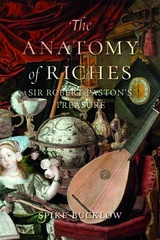
Beginning with the travels of Sir Robert’s father Sir William, the Paston wealth brought luxuries from across the globe to an idyllic retreat in rural Norfolk. There, the family commissioned Europe’s finest craftsmen to enhance their exotic rarities, a trove of objects that included everything from musical instruments to bejeweled ostrich eggs and nautilus shell goblets. The lavish hospitality of the Paston family was renowned throughout England, but the English Civil War and plague tore the country apart, and peace-loving Sir Robert was assailed by what he called a “whirlpool of misadventures.” As the dawn of the modern era saw the beginning of the family’s loss of fortune, Sir Robert kept faith and worked tirelessly to protect his wife and children. Encouraged by his friend Dr. Thomas Browne, he even found time to pursue his own idiosyncratic interests, employing both an alchemist in search of the Philosophers’ Stone and an artist to capture his favorite treasures in an enigmatic still life, The Paston Treasure. Exploring the Paston family’s history through their collection and this famed painting, The Anatomy of Riches offers a history of both early modern England and the modern world’s birth-pangs.
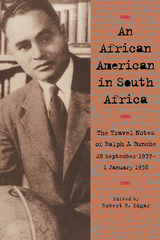
Ralph Bunche, who received the Nobel Peace Prize in 1950, traveled to South Africa for three months in 1937. His notes, which have been skillfully compiled and annotated by historian Robert R. Edgar, provide unique insights on a segregated society.
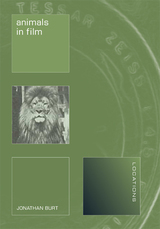
In Animals in Film, Jonathan Burt points out that the mobility of animals presented technical and conceptual challenges to early film-makers, the solutions of which were an important factor in advancing photographic technology, accelerating the speed of both film and camera. The early filming of animals also marked one of the most significant and far-reaching changes in the history of animal representation, and has largely determined the way animals have been visualized in the twentieth century.
Burt looks at the extraordinary relation-ship between animals, cinema and photography (including the pioneering work of Eadweard Muybridge and Jules-Etienne Marey) and the technological developments and challenges posed by the animal as a specific kind of moving object. Animals in Film is a shrewd account of the politics of animals in cinema, of how movies and video have developed as weapons for animal rights activists, and of the roles that animals have played in film, from the avant-garde to Hollywood.

Animals, Aging, and the Aged was first published in 1981. Minnesota Archive Editions uses digital technology to make long-unavailable books once again accessible, and are published unaltered from the original University of Minnesota Press editions.
This volume explores the significant contributions of animals to our understanding of aging, to improving geriatric medicine, and to providing companionship and assistance to the elderly. Leo L. Bustad discusses what can be learned from animal life-span studies about the process of aging, including the problems of cardiovascular disease, cancer, osteoporosis, and age-related mental conditions. The results of these studies suggest that changes in life-style—especially the diet—may modify the effects of chronic degenerative diseases.
Other studies show that caring for a pet can contribute greatly to the health and well being of the elderly. Bustad surveys experiments using animals in therapy and he presents, for the first time, evaluative instruments for choosing the appropriate pet. Companion animals allow many elderly people to maintain their independence. Animals are also helpful as aids for those with visual, hearing, and physical impairments. An appendix lists agencies that train dogs as aids to the physically impaired.
Animals, Aging, and the Aged is a thoughtful discussion of the physical, psychological, and social problems faced by the elderly, with emphasis on the ways that animals have contributed to the solution of some of those problems. As such, it will be useful for those involved in geriatric medicine and social work and in veterinary medicine and research. This book is volume 5 in the series Wesley W. Spink Lectures in Comparative Medicine.

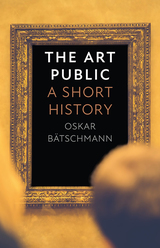
The Art Public explores the history of efforts to imagine a collective, general audience for art in the world. Oskar Bätschmann explores both written and pictorial evidence of the development of the “art public” as an idea and disentangles connections between art production, audiences, and actual reception. Two aspects shape the narrative: the transformation of the audience from passive recipient to active agent as well as satirical jabs at audiences by the likes of Cruikshank, Rowlandson, and Daumier. This sweeping account connects the ancient Greeks with Renaissance painters, modern writers, and contemporary movie stars in a deft survey of the ways we imagine art’s immediate impact on audiences and its afterlives in museums, galleries, and the world.
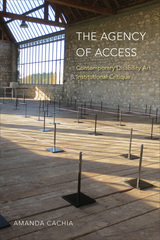

Arrivals, inspections, victories.
In this volume are three works concerning the campaigns engaged in by the great Roman statesman Julius Caesar (100–44 BC), but not written by him. The Alexandrian War, which deals with troubles elsewhere also, may have been written by Aulus Hirtius (ca. 90–43 BC, friend and military subordinate of Caesar), who is generally regarded as the author of the last book of Caesar’s Gallic War. The African War and the Spanish War are detailed accounts clearly by officers who had shared in the campaigns. All three works are important sources of our knowledge of Caesar’s career.
The Loeb Classical Library edition of Caesar is in three volumes.


American Policy Toward Communist Eastern Europe was first published in 1965. Minnesota Archive Editions uses digital technology to make long-unavailable books once again accessible, and are published unaltered from the original University of Minnesota Press editions.
Perhaps no aspect of American foreign relations has been in greater need of clarification and understanding than our policy toward the Communist nations of Eastern Europe, both as to what has happened in the past and what is possible for the future. In this book a former State Department Official, now on the staff of the Council on Foreign Relations, provides objective information which will help students, professors, members of adult study groups, and others concerned with American foreign policy to understand and discuss this important subject.
Mr. Campbell reminds us that the cold war began in Eastern Europe in the aftermath of the second World War. Since that time, the question of what to do about Eastern Europe has been in the forefront of American foreign policy. For some years, he contends, we have been uncertain of our objectives and ambivalent in our policies. Meanwhile, changes since the death of Stalin have created new situations both for the Soviet Union and for the West.In analyzing what has happened, the author emphasizes the forces which have shaken the unity of the Soviet bloc to create new perspectives and possibilities. He discusses the effects of the Soviet- Chinese split, the relationship of the German question to that of Eastern Europe, and the phenomenon of national Communism as it has appeared in different forms in Yugoslavia, Poland, Rumania, and elsewhere.After presenting the historical background, the author discusses American aims and current policies and outlines the choices he sees ahead. He does not plead for any one of the alternative lines of action, presenting them, rather, as a basis for reasoned consideration and debate.

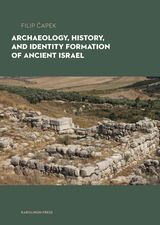
When did Israel begin? The origins of ancient Israel are shrouded in mystery, and those hoping to explore the issue must utilize resources from three different fields—archaeology, epigraphy, and biblical texts—and then examine their interrelations while keeping in mind that the name Israel was not used to describe just one state but referred to numerous entities at different times.
Archaeology, History, and Formation of Identity in Ancient Israel provides a critical reading of Israel’s history. It is neither a harmonizing reading, which takes the picture painted by texts as a given fact, nor a reading supporting biblical texts with archaeological and epigraphic data; instead, it offers the reader multiple options to understand biblical narratives on a historical and theological level. In addition to presenting the main currents in the field, the book draws upon the latest discoveries from Czech-Israeli excavations to offer new hypotheses and reconstructions based on the interdisciplinary dialogue between biblical studies, archaeology, and history.
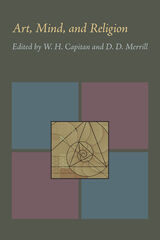

All Faithful People was first published in 1983. Minnesota Archive Editions uses digital technology to make long-unavailable books once again accessible, and are published unaltered from the original University of Minnesota Press editions.
In 1924 Robert and Helen Lynd went to Middletown (Muncie, Indiana) to study American institutions and values. The results of their work are the classic studies Middletown (1929) and Middletown in Transition (1937). In the late 1970s a team of social scientists returned to Middletown to gauge the changes that have taken place in the fifty years since the Lynds' first visit. The Middletown III Project, by replicating the earlier work, in some cases by using the same questions, provides an unprecedented portrait of a small American town as it adapts to changing times. Its first report, Middletown Families, was published by Minnesota in 1982.
This book explores the role of religion in the life of Middletown. Using the Lynds' magnificent cache of empirical data as a base, social scientists on the Middletown III Project attempted to gauge how religious beliefs and practices have changed. For the most part, their findings show that the current perception of a trend toward a more secular society is not true. In Middletown, religion seems to be more important than ever.
All Faithful People also covers the history of Middletown's churches, the differences between the town's Protestants and Catholics, religious participation among young people, and the role in Middletown life of private devotions and public rituals. In conclusion, the authors of All Faithful People evaluate Middletown as a representative community. They attempt to explain the myth of the death of organized religion, and briefly compare religion in America to religion in other Western countries.
Fifty years after the Lynds first made Middletown famous, a team of social scientists returned to find out how American values have changed. This, their second report, focuses on religion. What does religion mean to Middletown today? Has America become a secular society? Those are some of the questions discussed in All Faithful People.
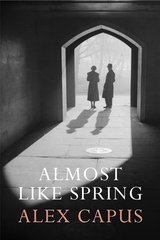
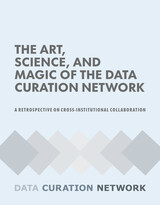
The Art, Science, and Magic of the Data Curation Network: A Retrospective on Cross Institutional Collaboration captures the results of a project retrospective meeting and describes the necessary components of the DCN’s sustained collaboration in the hopes that the insights will be of use to other collaborative efforts. In particular, the authors describe the successes of the community and challenges of launching a cross-institutional network. Additionally, this publication details the administrative, tool-based, and trust-based structures necessary for establishing this community, the “radical collaboration” that is the cornerstone of the DCN, and potential future collaborations to address shared challenges in libraries and research data management. This in-depth case study provides an overview of the critical work of launching a collaborative network and transitioning to sustainability. This publication will be of special interest to research librarians, data curators, and anyone interested in academic community building.

Among the most dynamic and influential literary texts of the European sixteenth century, Ludovico Ariosto’s Orlando Furioso (1532) emerged from a world whose horizons were rapidly changing. The poem is a prism through which to examine various links in the chain of interactions that characterized the Mediterranean region from late antiquity through the medieval period into early modernity and beyond. Ariosto and the Arabs takes as its point of departure Jorge Luis Borges’s celebrated short poem “Ariosto y los Arabes” (1960), wherein the Furioso acts as the hinge of a past and future literary culture circulating between Europe and the Middle East. The Muslim “Saracen”—protagonist of both historical conflict and cultural exchange—represents the essential “Other” in Ariosto’s work, but Orlando Furioso also engages with the wider network of linguistic, political, and faith communities that defined the Mediterranean basin of its time.
The sixteen contributions assembled here, produced by a diverse group of scholars who work on Europe, Africa, and Asia, encompass several intertwined areas of analysis—philology, religious and social history, cartography, material and figurative arts, and performance—to shed new light on the relational systems generated by and illustrative of Ariosto’s great poem.


Richard Caves analyzes the market structure, conduct, and performance of the United States domestic passenger airlines. A unique aspect of the industry is the close regulation of its daily business functioning by the Civil Aeronautics Board. Although this influence affects every managerial decision, Caves finds that the economic elements in the industry's market structure still play a vital role in determining performance and conduct. He shows that the airline industry has structural characteristics that would ensure market performance of reasonable quality with less extensive economic regulation.
His book is more than a comprehensive evaluation of the air-transport industry; it is concerned with the basic question of governmental control. Questions of regulation, already materially affecting the American economy, are often before the public. Such industry studies as this clarify the net effect on the general economic welfare of industrial controls—how they work, where they work best, and the advantages of increasing or decreasing them.
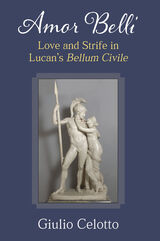
Compelled by the emperor Nero to commit suicide at age 25 after writing uncomplimentary poems, Latin poet Lucan nevertheless left behind a significant body of work, including the Bellum Civile (Civil War). Sometimes also called the Pharsalia, this epic describes the war between Julius Caesar and Pompey.Author Giulio Celotto provides an interpretation of this civil war based on the examination of an aspect completely neglected by previous scholarship: Lucan’s literary adaptation of the cosmological dialectic of Love and Strife.
According to a reading that has found favor over the last three decades, the poem is an unconventional epic that does not conform to Aristotelian norms: Lucan composes a poem characterized by fragmentation and disorder, lacking a conventional teleology, and whose narrative flow is constantly delayed. Celotto’s study challenges this interpretation by illustrating how Lucan invokes imagery of cosmic dissolution, but without altogether obliterating epic norms. The poem transforms them from within, condemning the establishment of the Principate and the Julio-Claudian dynasty.

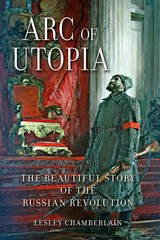
Arc of Utopia offers a fresh look at these German philosophical origins of the Russian Revolution. In the book, Lesley Chamberlain explains how influential German philosophers like Kant, Schiller, and Hegel were dazzled by contemporary events in Paris, and how this led a century later to an explosion of art and philosophy in the Russian streets, with a long-repressed people reinventing liberty, equality, and fraternity in their own cultural image. Chamberlain examines how some of the greatest Russian names of the nineteenth-century—from Alexander Herzen to Mikhail Bakunin, Ivan Turgenev to Fyodor Dostoevsky—defined their visions for Russia in relationship to their views on German enthusiasm for revolutionary France.
With the centenary of the Russian Revolution approaching, Arc of Utopia is an important and timely revisioning of this tumultuous moment in history.


An American Social Worker in Italy was first published in 1961. Minnesota Archive Editions uses digital technology to make long-unavailable books once again accessible, and are published unaltered from the original University of Minnesota Press editions.
Mrs. Charnley, an American social worker, spent six months in Italy on a Fulbright grant as a consultant to Italian child welfare agencies and schools of social work. Here, in diary form, she tells of her experiences during those months when she struggled to teach American social work principles to her Italian colleagues. The task was complicated not only by the need to communicate in a newly learned tongue but also by the necessity to tailor American casework philosophies to a vastly different culture. The story abounds in humor and pathos and, at the same time, offers rich information about Italy, its people, and its child-care methods and institutions.
Mrs. Charnley points out that one Italian child in ten spends his first seventeen years in an institution. The nation's laws for the protection of children date back to the Caesars; even the most progressive of the social workers she met hoped for reforms only in terms of decades or centuries. Against this background, the situations in which she found herself were sometimes frustrating, often comic, always challenging. Her determination to help Italy's half-million institutionalized children took her behind the doors of many orphanages and convents, into close contact with the children and the nuns and priests who cared for them. She studied the records of social agencies, analyzed problems with their staffs, and lectured at social work schools.
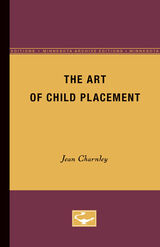

The Arabic Language was first published in 1969. Minnesota Archive Editions uses digital technology to make long-unavailable books once again accessible, and are published unaltered from the original University of Minnesota Press editions.
Arabic, with its rich literary heritage, is one of the major languages of the world. It is spoken by about one hundred million people inhabiting a wide and important area of the Middle East. Yet the language and its significant role in history are little known in the English-speaking countries except among specialists. This book will, it is hoped, help to introduce the language and demonstrate its importance to a wider audience.
Professor Philip K. Hitti of Princeton University writes in the foreword: "Until recently Arabic studies in this country had been limited to the graduate level and confined to a few universities. Since World War II they have inched their way to the undergraduate curriculum of a small number of universities. But they are still top-heavy and anemic. They will so remain unless they send their roots deeper down into high schools and enlist the interest of a widening circle of nonspecialists.
"Hence the value of this work by Professor Chejne. It is a commendable attempt to introduce the Arabic language, with its features and problems, to students and nonspecialists, to tell the story of its dramatic evolution from a tribal dialect to one of the few carriers of world culture, to indicate its unique relation to the religion of Islam and its role in the development of modern Arab nationalism. The book, written in a language intelligible to the layman, sums up what is already known and presents the contribution of the author."
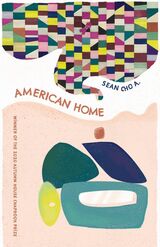
Sean Cho A.’s debut poetry chapbook directs a keen eye on everyday occurrences and how these small events shape us as individuals. This collection is filled with longing for love, understanding, and simplicity. But these poems also express great pleasure in continued desire. With exuberant energy that flows through the collection, the speaker announces: “I won’t apologize for the smallness of my delights.” Filled with questions and wonder, these poems revel in the unknowing and liminal spaces, and we as readers are invited to join in this revelry. Cho A.’s poetry reminds and allows us to pause, to wonder, and enjoy our many pleasures.
American Home was selected by Danusha Laméris for the 2020 Autumn House Chapbook Prize.
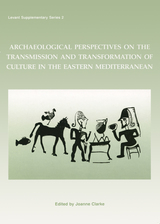


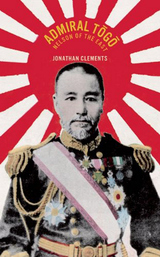

Tokyo, meaning “Eastern Capital,” has only enjoyed that name and status for 150 years. Before that, it was a medieval outpost designed to keep watch over rich farmlands. But this seemingly unassuming geographical location ultimately led to its status as a supercity. Though the imperial court ruled Japan from the sleepy city of Kyoto, the landowners of the Kanto plain where Tokyo lies held the true wealth and power in Japan, which they eventually asserted in a series of bloody civil wars. The Tokyo region became the administrative center of Japan’s Shogun overlords and the site of a vibrant urban culture home to theaters, taverns, and brothels. After the Meiji Restoration in 1868, it became Japan’s true capital, home to the emperors, the seat of government, and a site of rapid urban growth.
Anyone who’s ever longed to look upon Mount Fuji, embody the bravery of the Samurai, or savor the world’s finest sushi will find themselves transported from the comfort of their armchair while reading Clements’s account of Tokyo.
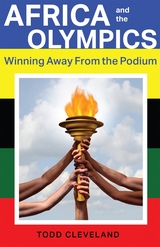
At the 2020 Tokyo Olympic Games (held in 2021 due to COVID-19), the fifty-four African countries that participated finished the tournament with the lowest medal haul for any continent, continuing a historic trend since the inception of the modern Games in 1896. Reflecting this relative lack of sporting success, African Olympians—aside from elite Kenyan distance runners—rarely register in the minds of even the most dedicated followers of the Games. Yet for all their seeming invisibility on the Olympic landscape, African states, athletes, and officials have long been “winning” at the Olympics, albeit often far removed from the medal podium. Africa and the Olympics shows how African actors have achieved these nonsporting victories and examines how they have used the Olympics to engage in transformative political activity, realize social mobility, and enhance the quality of life for individuals, communities, and entire nations. In tracing these historical and contemporary processes and the motivations that underlie them, the book complicates reductive notions of the Olympics as solely a sporting competition and instead considers Africa’s engagement with the Games as a series of opportunities to improve personal, communal, ethnic, national, and even continental plights. If few sports fans have thought extensively about Africa and the Olympics, scholars have been only slightly more engaged with the subject. Most of this scholarship focuses on the International Olympic Committee’s ban of apartheid South Africa from 1964 to 1988. Other works that consider the Olympics more broadly tend to deal with Africa only summarily, further reducing its already low profile. As a result, the academic literature resembles a patchwork of circumscribed studies dispersed in a range of fields and disciplines. Not since the publication of Africa at the Olympics almost fifty years ago has a single volume featured a comprehensive history of the continent and the Games. This book both updates and expands previous work and, most importantly, reframes the analytical engagement with this topic.

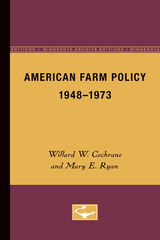
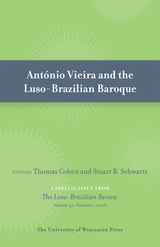
Preacher, politician, natural law theorist, administrator, diplomat, polemicist, prophetic thinker: Vieira was all of these things, but nothing was more central to his self-definition than his role as missionary and pastor. Articles in this issue were originally presented at a conference, “The Baroque World of Padre António Vieira: Religion, Culture and History in the Luso-Brazilian World,” Yale University, November 7–8, 1997, commemorating the three hundredth anniversary of Vieira’s death.
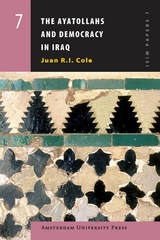


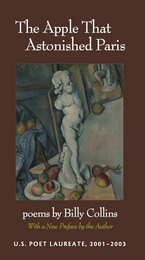
Bruce Weber in the New York Times called Billy Collins “the most popular poet in America.” He is the author of many books of poetry, including, most recently, The Rain in Portugal: Poems.
In 1988 the University of Arkansas Press published Billy Collins’s The Apple That Astonished Paris, his “first real book of poems,” as he describes it in a new, delightful preface written expressly for this new printing to help celebrate both the Press’s twenty-fifth anniversary and this book, one of the Press’s all-time best sellers. In his usual witty and dry style, Collins writes, “I gathered together what I considered my best poems and threw them in the mail.” After “what seemed like a very long time” Press director Miller Williams, a poet as well, returned the poems to him in the “familiar self-addressed, stamped envelope.” He told Collins that there was good work here but that there was work to be done before he’d have a real collection he and the Press could be proud of: “Williams’s words were more encouragement than I had ever gotten before and more than enough to inspire me to begin taking my writing more seriously than I had before.”
This collection includes some of Collins’s most anthologized poems, including “Introduction to Poetry,” “Another Reason Why I Don’t Keep a Gun in the House,” and “Advice to Writers.” Its success over the years is testament to Collins’s talent as one of our best poets, and as he writes in the preface, “this new edition . . . is a credit to the sustained vibrancy of the University of Arkansas Press and, I suspect, to the abiding spirit of its former director, my first editorial father.”
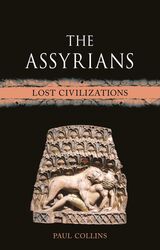
At the height of its power near 660 BC, the Assyrian empire, centered in northern Iraq, wielded dominance from Egypt to Iran. This vast region was ruled by a series of kings who demonstrated their power with magnificent palaces adorned by sculptures depicting rituals, battles, and hunts. Established by military might, the empire thrived under the guidance of scholars who interpreted divine will and administrators who relocated tens of thousands of people to serve the state. This book relates the history of Assyria through the lens of its royal family and the officials who commissioned its buildings, art, and literature—each a critical part of the foundation for the later Babylonian and Persian empires.
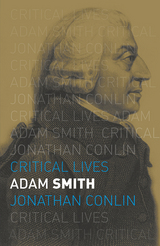
As Conlin shows, Smith rooted our instincts to trade in human psychology. Analyzing the contrasts he saw between the industrializing Scottish lowlands and the clan-based pastoralism of the Scottish highlands—as well as the contrasts between the ideas of contemporary thinkers such as Jean-Jacques Rousseau and David Hume—Smith advanced a system of ethics founded on sympathy. Weaving together Smith’s life and ideas, Conlin shows how the latter anticipated much more recent developments surrounding behavioral economics, virtue ethics, and social inequality. Ultimately, Conlin argues, Adam Smith offers us a set of tools to face today's challenges and become better and happier human beings.
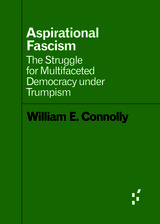
Coming to terms with a new period of uncertainty when it is still replete with possibilities
This quick and engaging study clearly lays out the United States’ current democratic crisis. Examining the early stages of the Nazi movement in Germany, William E. Connolly detects synergies with Donald Trump’s rhetorical style. Tapping into a sense of contemporary fragility, Aspirational Fascism pays particular attention to how conflicts between neoliberalism and the pluralizing left have placed the white working class in a bind. Ultimately, Connolly believes a multifaceted democracy constitutes the best antidote to aspirational fascism and rethinks what a politics of the left might look like today.
Forerunners is a thought-in-process series of breakthrough digital works. Written between fresh ideas and finished books, Forerunners draws on scholarly work initiated in notable blogs, social media, conference plenaries, journal articles, and the synergy of academic exchange. This is gray literature publishing: where intense thinking, change, and speculation take place in scholarship.
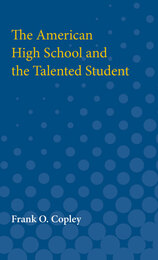

Daniel Cordier’s fascinating, intimate memoir is a major contribution to our understanding of the fraught and historic relations between General Charles de Gaulle’s Free French and the fractious resistance movements under the Occupation during World War II. As the first young secretary to legendary Jean Moulin, one of the leaders of Conseil National de la Résistance, Cordier recounts Moulin’s tense negotiations to bring together the resistance movements and persuade them to join forces under de Gaulle’s banner between 1942 and ‘43. Cordier was a lookout on the fateful day the National Resistance Council was created, confirming de Gaulle’s legitimacy in the eyes of the French people and, crucially, in the eyes of Roosevelt and the Allied leadership. Later in life, Cordier penned his first-hand account of his role in the creation of Jean Moulin’s secretariat in Lyon and then Paris. Alias Caracalla is a brave and passionate story of action and self-discovery in times of war, with a sensitive and nuanced translation by Rupert Swyer.
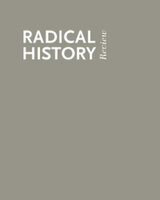
The collection argues that radical movements offer an intriguing counternarrative to the more familiar history of imperialism and globalization in the twentieth century. One essay illuminates the radical anticolonial and diasporic South Asian Ghadar movement, which worked to free India from British rule. Another delves into the global politics of South African radicalism between antifascism and apartheid in the 1940s and 1950s. A third essay explores the encounter between U.S. black activists and Cuban revolutionaries in the 1960s. In an interview, a Latina activist illustrates the transnational scope of contemporary social movements by describing her organizing work among immigrants in Atlanta, Georgia.
Contributors. Adina Black, Mansour Bonakdarian, Duane J. Corpis, Ian Christopher Fletcher, Yael Simpson Fletcher, Robert Gregg, Bob Hannigan, Chia Yin Hsu, Madhavi Kale, R. J. Lambrose, Christopher Joon-Hai Lee, Teresa Meade, Adelina Nicholls, Enrique C. Ochoa, Susan D. Pennybacker, Maia Ramnath, Besenia Rodriguez
Another World Was Possible is the companion issue to Two, Three, Many Worlds (Radical History Review, #91).
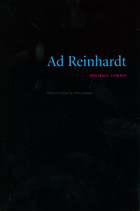
A pioneering avant-garde artist with fierce political beliefs, Reinhardt immersed himself in the vibrant left-wing political and cultural circles of the 1930s and ’40s, only to be marginalized by the social and cultural conservatism that arose in postwar America. Corris examines Reinhardt’s work against this historical background, charting the development of his entire oeuvre, ranging from his abstract paintings to his popular graphic artwork, illustrations and cartoons. Ad Reinhardt also re-evaluates Reinhardt’s role and influence in the art world, chronicling his time as an artist and educator at the California School of Fine Arts, University of Wyoming, Yale University, and Hunter College, and examining his influence on younger artists who created successive avant-garde movements such as minimal and conceptual art.
A long-awaited examination of a less-heralded American master, Ad Reinhardt is a fascinating portrait of an artist whose political radicalism infused his art with a poignant resonance that stretches, through this rediscovery, into the present.
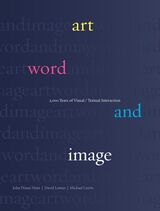
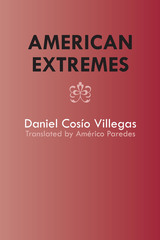
In this notable collection of essays, written in the middle of the twentieth century, a towering Mexican thinker discusses both Latin America's internal problems and its relations with the United States, Russia, and the rest of the world. This perceptive examination of many political and economic topics will be of interest to all readers concerned with what our southern neighbors think on subjects important to us.
The author brings into particularly sharp focus the relationship of Mexico and other Latin American countries to the United States. Cosío Villegas bluntly tells the reader how much remains to be accomplished: " . . . I believe that Mexico and the United States are so far from resolving their problems that, in truth, it can be said that the process of understanding has not yet even begun." He then impartially analyzes the problems that stand in the way of improved relations, and he looks at these difficulties from an altogether fresh perspective.
Another major theme is the Mexican Revolution, what it did, and what it became. In many important ways, the author feels, the Revolution failed. For the rejuvenation that Mexico needs, should it look toward the United States or toward Russia? And what resources within itself does it need to develop in order to provide the leadership that Latin America requires? Cosío Villegas evaluates the permanent impact of the Cuban Revolution on our hemisphere. He considers where Latin American interests lie in the cold war and suggests how that area may use its voice most effectively in global decisions.
With the increase in world tensions and the decrease in world size, this book will be extremely valuable for every thinking citizen.

Addressing a growing area of focus in contemporary art, Aesthetic Journalism investigates why contemporary art exhibitions often consist of interviews, documentaries, and reportage. Art theorist and critic Alfredo Cramerotti traces the shift in the production of truth from the domain of the news media to that of art and aestheticism—a change that questions the very foundations of journalism and the nature of art. This volume challenges the way we understand art and journalism in contemporary culture and suggests future developments of this new relationship.
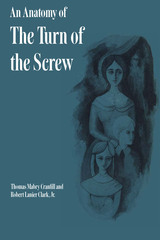
The ambiguous intent of Henry James’s horror story The Turn of the Screw has fascinated and divided its readers since its publication in 1898. The division arises between the apparitionists and the nonapparitionists in interpretation of the plot and the characters. Thomas Mabry Cranfill and Robert Lanier Clark, Jr., have here taken up the argument and made an interpretation of their own.
The authors carefully considered the mountainous critical comment, studied James’s statements regarding his intent, and minutely scrutinized the story itself. After all this probing of opinions and following of clues and observing of human beings in action, they have come out strongly on the side of the nonapparitionists.
The authors base their conclusion on analyses of character, centrally that of the governess, whom they consider the protagonist of the fearsome drama, but peripherally those of Mrs. Grose, the children, the uncle in Harley Street, and even the deceased Miss Jessel and Peter Quint. Relentlessly they relate every episode, action, and speech to the character of the governess and her relationships with those around her at Bly, picturing her as a psychological “case” whose abnormal mental state brings to those around her the inescapable misery they all suffer.
The authors’ analysis unfolds as interestingly in terms of character and motive as if the reader did not already know what happens in James’s much-read story. It moves, moreover, with something of the same suspense as James’s horror tale, although the tension is intellectual rather than emotional. Each additional disclosure of evidence, the resolution of each situation, and the clarification of every puzzling ambiguity builds the analysis step-by-inevitable-step to its inescapable conclusion.
The style of the analysis is graceful, urbane, and witty. The introduction gives an excellent appraisal of literary comment on James’s story and an illuminating summary of the literary “war” over the meaning of it; the bibliography provides an impressive list of books and articles on this subject, annotated to indicate in what particular ways each makes a contribution to the controversy.
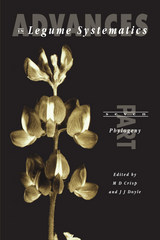

Focusing on a range of periods in places from France to the Balkans and from Siberia to San Diego, essays center on such subjects as the “global garden,” Lockean landscapes, ecohistory, nineteenth-century Australian and North American landscape painting, and zoos. Helping to ground the collection in its project of illuminating both the earthly reality and the metaphorical richness of landscape are two photoessays that focus on “unsettled” sites of the Far East and American West.
Contributors. Ruth Beilin, Tim Bonyhady, John Bradley, Tom Conley, Michael Crizier, Thomas Lahusen, Artemis Leontis, Anders Linde-Laursen, Robert M. Markley, Louis A. Ruprecht Jr., Susan Willis

The natural world is filled with diverse—not to mention quirky and odd—animal behaviors. Consider the male praying mantis that continues to mate after being beheaded; the insects, insects, and birds that offer gifts of food in return for sex; the male hip-pocket frog that carries his own tadpoles; the baby spiders that dine on their mother; or the starfish that sheds an arm or two to escape a predator's grasp. In Ain’t Love Grand, Marty Crump—a tropical field biologist well known for her work with the reproductive behavior of amphibians—examines the bizarre conduct of animals as they mate, parent, feed, defend themselves, and communicate. More importantly, Crump points out that diverse and unrelated animals often share seemingly erratic behaviors—evidence, Crump argues, that these natural histories, though outwardly weird, are actually successful ways of living.
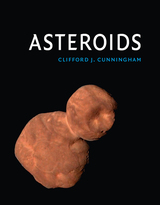



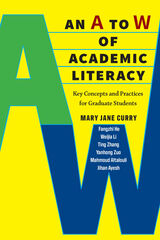
The guide includes 65 common academic literacy terms and explores how they relate to genres, writing conventions, and language use. Each entry briefly defines the term, identifies variations and tensions about its use across disciplines, provides examples, and includes reflection questions. An appendix lists further readings for each entry.
Unique to this volume are comments featuring the experiences of the graduate students who wrote the entries, comments that bring each entry to life and build a bridge to graduate student readers.
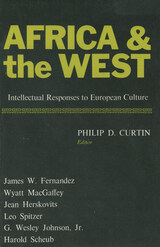
“This book offers some exciting examples of the insights to be gained from studies of the intellectual responses of Africans to the West. In six case studies, anthropologists, historians, and a literary critic study the impact of the West on African patterns of thought.”—Library Journal



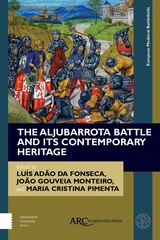

Alms for Oblivion was first published in 1967. Minnesota Archive Editions uses digital technology to make long-unavailable books once again accessible, and are published unaltered from the original University of Minnesota Press editions.
This volume makes available in book form a collection of seventeen essays by Edward Dahlberg, who has been called one of the great unrecognized writers of our time. Some of the selections have never been published before; others have appeared previously only in magazines of limited circulation. There is a foreword by Sir Herbert Read.
The individual essays are on a wide range of subjects: literary, historical, philosophical, personal. The longest is a discussion of Herman Melville's work entitled "Moby-Dick - A Hamitic Dream." The fate of authors at the hands of reviewers is the subject of the essay called "For Sale." In "No Love and No Thanks" the author draws a characterization of our time. He presents a critique of the poet William Carlos Williams in "Word-Sick and Place- Crazy," and a discussion of F. Scott Fitzgerald in "Peopleless Fiction." In "My Friends Stieglitz, Anderson, and Dreiser" he discusses not only Alfred Stieglitz, Sherwood Anderson, and Theodore Dreiser but other personalities as well. He also writes of Sherwood Anderson in "Midwestern Fable." In "Cutpurse Philosopher" the subject is William James. "Florentine Codex" is about the conquistadores. Other essays in the collection are the following: "Randolph Bourne," "Our Vanishing Cooperative Colonies," "Chivers and Poe," "Domestic Manners of Americans," "Robert McAlmon: A Memoir," "The Expatriates: A Memoir," and an essay on Allen Tate.

Is an artist-teacher a mere professional who balances a career—or does the duality of making and teaching art merit a more profound investigation? Rejecting a conventional understanding of the artist-teacher, this book sets out to present a robust history from the classical era to the twenty-first century. Particular pedagogical portraits—featuring George Wallis, Walter Gropius, Johannes Itten, Victor Pashmore, Richard Hamilton, Arthur Wesley Dow, and Hans Hofmann—illustrate the artist-teacher in various contexts. This book offers a revelation of the complex thinking processes artists utilize when teaching, and a reconciliation of the artistic and educational enterprises as complimentary partners.

The Important Plant Areas of Mozambique is based on the Mozambique TIPAs project run in collaboration between Royal Botanic Gardens, Kew, Mozambique’s Agricultural Research Institute (Instituto de Investigação Agrária de Moçambique – IIAM), and the University Eduardo Mondlane. Drawing on information from the TIPAs database, The Important Plant Areas of Mozambique includes color maps and photographs, site descriptions, and tables to present information on the botanical significance, habitat, and geology of the region. The book will also address conservation issues and ecosystem services to promote Mozambique’s critical plant sites and inform conservation leaders in government, NGOs, universities, and local communities about Mozambique’s threatened habitats.
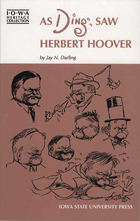
Ding Darling was a Pulitzer Prize-winning editorial cartoonist whose work appeared daily on the front page of the Des Moines Register between 1906 and 1949 and also was syndicated in 135 newspapers across the country. A brief encounter with Herbert Hoover during World War I was the beginning of a friendship that lasted until Ding’s death in 1962. After Hoover’s election as president, Ding’s relationship changed somewhat from one of strictly a friend to one of an unofficial advisor. On at least three occasions, the Darlings were overnight guests at the White House. Although their friendship deepened after the years of the presidency, Ding did not agree with Hoover on everything. In As “Ding” Saw Herbert Hoover, Ding interprets the career of Hoover as food administrator, cabinet member, candidate, and president in 57 cartoons, personal recollections, and a running commentary of the times as told in the day-by-day headlines.

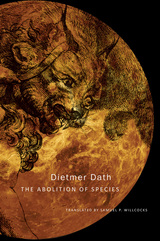
Cyrus the Lion sends the wolf Dmitri Stepanovich on a diplomatic mission, and in the course of his journey he discovers truths about natural history, war, and politics for which he was unprepared. The subsequent war that breaks out in The Abolition of Species will come to span three planets and thousands of years—encompassing treachery and massacres, music and mathematics, savagery and decadence, as well as the terraformation of Mars and Venus and the manipulation of time itself. By turns grandiose, horrific, erotic, scathing, and visionary, The Abolition of Species is a tale of love and war after the fall of man and an epic meditation on the theory of evolution unlike any other.
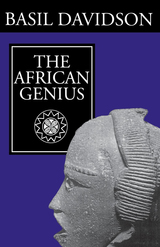
The African Genius presents the ideas, social systems, religions, moral values, arts, and metaphysics of a range of African peoples. Basil Davidson points toward the Africa that might emerge from an ancient civilization that was overlaid and battered by colonialism, then torn apart by the upheaval of colonialism’s dismantlement. Davidson disputes the notion that Africa gained under colonialism by entering the modern world. He sees, instead, an ancient order replaced by modern dysfunction. Davidson’s depiction of the sophisticated “native genius” that has carried Africans through centuries of change is vital to an understanding of modern Africa as well.

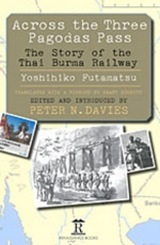

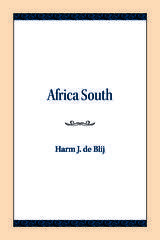
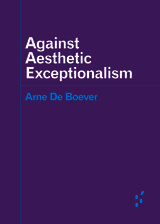
Reconsiders exceptionalism between aesthetics and politics
Here, Arne De Boever proposes the notion of aesthetic exceptionalism to describe the widespread belief that art and artists are exceptional. Against Aesthetic Exceptionalism challenges that belief by focusing on the sovereign artist as genius, as well as the original artwork as the foundation of the art market. Engaging with sculpture, conceptual artwork, and painting by emerging and established artists, De Boever proposes a worldly, democratic notion of unexceptional art as an antidote to the problems of aesthetic exceptionalism.
Forerunners: Ideas First
Short books of thought-in-process scholarship, where intense analysis, questioning, and speculation take the lead

Offers a philosophical perspective on the nature and value of writing a memoir.
Artful Truths offers a concise guide to the fundamental philosophical questions that arise when writing a literary work about your own life. Bringing a philosopher’s perspective to a general audience, Helena de Bres addresses what a memoir is, how the genre relates to fiction, memoirists’ responsibilities to their readers and subjects, and the question of why to write a memoir at all. Along the way, she delves into a wide range of philosophical issues, including the nature of the self, the limits of knowledge, the idea of truth, the obligations of friendship, the relationship between morality and art, and the question of what makes a life meaningful.
Written in a clear and conversational style, it offers a resource for those who write, teach, and study memoirs, as well as those who love to read them. With a combination of literary and philosophical knowledge, de Bres takes the many challenges directed at memoirists seriously, while ultimately standing in defense of a genre that, for all its perplexities—and maybe partly because of them—continually proves to be both beloved and valuable.
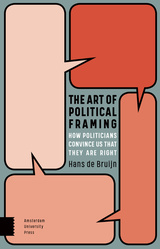
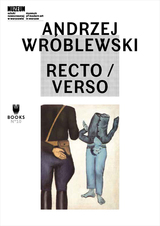

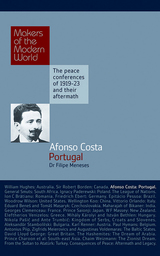
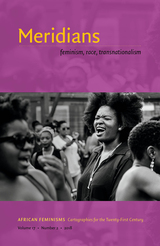
Contributors. Gabeba Baderoon, Abena P. A. Busia, Ginetta E. B. Candelario, Msia Kibona Clark, Alicia C. Decker, Chipo Dendere, Abosede George, Tsitsi Jaji, Selina Makana, Patricia McFadden, Anne Moraa, Jacqueline-Bethel Tchouta Mougoué, Neo Sinoxolo Musangi, Wambui Mwangi, Aziza Ouguir, Charmaine Pereira, Fatima Sadiqi, Toni Stuart, Makhosazana Xaba, Ntokozo Yingwana
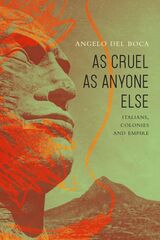
Between the end of the nineteenth century and over the first half of the twentieth, Italy invaded and occupied the Horn of Africa, Libya, and several other territories. Yet recognition of this history of colonial destruction, racist violence, and genocidal aerial and chemical warfare—carried out not only during the Fascist dictatorship but also under preceding liberal governments—has been consistently repressed beneath the myth that the Italians never truly practiced colonialism.
The late journalist, historian, novelist, campaigner, and former Resistance fighter Angelo Del Boca dismantles this myth. He expertly narrates episodes of state violence committed by Italians both abroad—from Ethiopia to Slovenia, from China to Libya—and “at home” during the civil war following Unification in the 1860s or when the anti-Fascist Resistance faced off against the Republic of Salò after 1943. Attentive to the losses and pain suffered by all sides in war, Del Boca deftly demonstrates how such violence was not only a tool of domination but has also been central to creating and shaping an Italian “people.”
Drawing on a lifetime of interviews as a special correspondent, decades of work in private and state archives, and his own experiences during the Second World War, Del Boca’s popular and influential work has contributed to overturning views of Italian history. Presenting many historical episodes in English for the first time, As Cruel as Anyone Else provides a key to reading contemporary Italy, its place in international politics, and the disturbing permanence of the far-right within mainstream Italian politics.



The American Writer and the European Tradition was first published in 1950. Minnesota Archive Editions uses digital technology to make long-unavailable books once again accessible, and are published unaltered from the original University of Minnesota Press editions.
In a series of perceptive essays by twelve scholars this volume brings a fresh viewpoint to the study of American literature. From the colonial gentlemen-scholars to contemporary poets and novelists, the American writer is seen in relation to the cultural influences that flowed from Europe to America, intermingled with native tendencies, and then flowed from America to Europe.
Three themes bind the essays together: What was the American writer's original heritage of European ideas? What ideas, moods, manners in American writers were indigenous, or mostly so, to America? And finally, what has been the influence of American letters abroad?

American Interests and Policies in the Middle East, 1900-1939 was first published in
1963. Minnesota Archive Editions uses digital technology to make long-unavailable books once again accessible, and are published unaltered from the original University of Minnesota Press editions.Scholars concerned with the diplomatic history of the United States have largely neglected the subject of American relations with the Middle East during the four decades before World War I. With this study, Professor DeNovo fills the gap by describing and assessing the United States' cultural, economic, and diplomatic relations with Turkey, Persia, and the Arab East in that period. He traces, chronologically and topically, the activities of such American interest groups as Protestant missionaries, educators, philanthropists, archaeologists, businessmen, and technical advisers, as well as the official actions of their government.
The account falls roughly into three chronological periods. The first section traces the interest groups through the pre-World War I years of political and cultural stirring in the Ottoman Empire and Persia. Special attention is given to the Chester Project for railroad development in Turkey. The second part deals with the upheavals accompanying World War I and the tasks of peacemaking from the Mudros armistice through the Lausanne settlement of 1923. The latter chapters detail the rise of the Turkish national movement, the deepening Persian and Arab nationalism, and the accommodation of American cultural and economic groups to these conditions. The author points out that before World War II began, Americans had acquired a significant interest in Middle Eastern oil and had become emotionally involved in the Arab-Zionist tension. In 1939 the United States was on the verge of a new phase in its Middle Eastern relations when that region would become more intimately linked to America's national security.
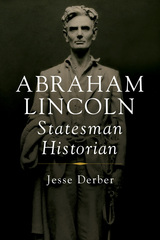
Abraham Lincoln drew upon history in his political career and particularly when crafting the rhetorical masterpieces that still resonate in the present day. Jesse Derber explores how Lincoln’s views of the limits of human understanding drove a belief in--and untiring pursuit of--historical truth.
Lincoln embraced the traditional ideas that good history made good statesmanship and that an understanding of the past informed decision-making in the present. Seeing history as a source of wisdom, Lincoln strove for accuracy through a combination of research, reasoning ability, emotional maturity, and a willingness to admit his mistakes and challenge his biases. His philosophy flowed from an idea that authentic history could enlighten people about human nature. Though he revered precedents, Lincoln understood the past could be imperfect, and that progress through change was an ineffable part of building a better nation.
Perceptive and revealing, Abraham Lincoln, Statesman Historian looks at how the Lincoln practiced history and applied its lessons to politics and leadership.
READERS
Browse our collection.
PUBLISHERS
See BiblioVault's publisher services.
STUDENT SERVICES
Files for college accessibility offices.
UChicago Accessibility Resources
home | accessibility | search | about | contact us
BiblioVault ® 2001 - 2024
The University of Chicago Press









